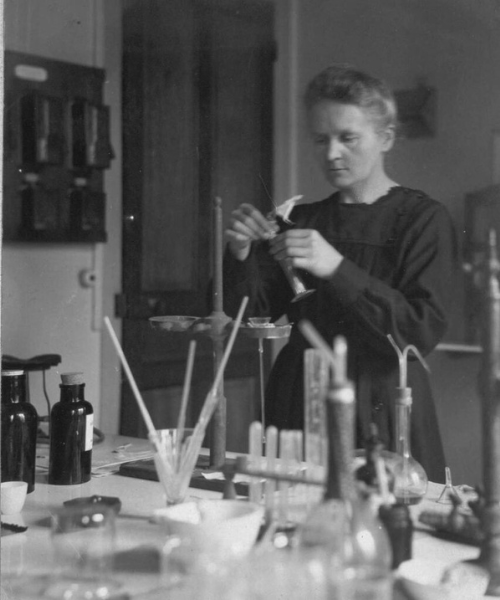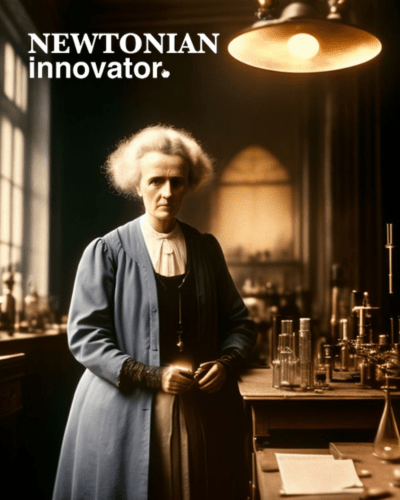Marie Curie’s pioneering research into radioactivity was nothing short of brilliant. Her relentless pursuit of understanding the properties of radium, a then mysterious and newly discovered element, changed the course of science. By examining the nature of radioactivity and making incredible discoveries, Curie’s innovative and curious mind paved the way for future scientific achievements.
Born in Warsaw, Poland, in 1867, Marie Curie (née Skłodowska) showed an exceptional aptitude for learning from an early age. Despite facing barriers as a woman in the scientific field, she continued her education in secret before moving to Paris to study physics and mathematics at the Sorbonne. There, she met and married Pierre Curie, the two of them together conducted groundbreaking research into radioactivity.

Marie Curie worked closely with her husband Pierre and other scientists, showing how important it is to collaborate. When people from different fields share ideas, they can do so much more together. These days, scientists are keeping that team spirit going. By partnering up with experts from all kinds of areas, they get to look at problems from different angles which leads to some really creative solutions! Tackling complicated issues takes people with diverse skills, by combining their brain power gives them a better shot at reaching their mutual goals.
Marie Curie’s approach to science was marked by keen observation, rigorous experimentation, and a willingness to challenge prevailing scientific ideas. Her thought experiments were often guided by her intuition, intellectual curiosity, and an unwavering belief in the scientific method. These mental exercises helped her conceptualize the behavior of radioactive substances, leading to her discovery of radioactive elements.
Curie’s fascination with radioactivity began when she learned of Henri Becquerel’s discovery of uranium’s ability to emit rays that could penetrate solid matter. Intrigued by this phenomenon, Curie set out on a quest to understand the nature of these mysterious rays. Her meticulous experiments led her to conclude that radioactivity was an atomic property, not merely a molecular interaction. This realization was revolutionary at a time when the structure of the atom was still largely a mystery.
Her investigation into the realm of radioactivity required a degree of critical and imaginative thinking that was well ahead of her time. As she dug into her research, Curie’s determination to comprehend the unknown drove her to a series of discoveries that would have a profound impact on both the scientific community and society as a whole. One in particular was radium, a radioactive element she and her husband Pierre discovered in 1898.
To isolate radium and to study its properties, the Curies undertook the difficult task of processing tons of pitchblende, a uranium-rich ore. Marie’s approach was marked by persistence and carefulness, she was guided by both logical reasoning and intuitive understanding of the dangers at hand.
Marie’s deep belief in her scientific convictions helped her to uncover radium’s properties. She was fascinated by its intense radioactivity and glow, conducting experiments to explore its potential applications. Curie’s thought process was characterized by a willingness to challenge assumptions, a focus on experimental evidence, and a creative approach to problem-solving.
Her research led her not only to radium, but also polonium, another radioactive element named after her native Poland. Her systematic exploration of radioactivity allowed her to detect this element, again revealing her unique ability to see beyond the surface and uncover deeper scientific truths regarding radioactivity.
Beyond her fundamental research, Curie discovered radium emitted sufficient radiation to make paper or film placed near it foggy. Her insight enabled the development of medical applications, as she realized radiation could destroy diseased tissues. Curie helped originate radium therapy, directing radiation sources precisely to target tumor cells. Her thought process transcended mere theoretical exploration as she was motivated by the desire to make tangible contributions to society.
Her work on radioactivity spanned the fields of physics and chemistry, illustrating the power of an interdisciplinary approach. By bridging different scientific domains, she was able to see connections and patterns that others may have missed. Modern scientists can embrace this interdisciplinary mindset by collaborating across fields and integrating different methodologies. This collaboration can lead to a more comprehensive understanding of complex phenomena and stimulate creative solutions to intricate problems.
Curie’s devotion to meticulous experimentation and data collection was a cornerstone of her success. Her careful handling of radium and other radioactive materials demonstrated an unwavering commitment to accuracy and precision. Modern scientists can emulate this commitment by upholding the highest standards of experimental design, data collection, and analysis. This rigor ensures that the conclusions drawn are robust and reliable, laying a solid foundation for further research.
Curie’s discoveries led to the creation of the Curie, a unit measuring radioactivity. This quantitative measure allowed systematic study of radiation’s bioeffects. Marie’s Curie unit remains a fundamental concept in radiation science.
Through a brilliant synthesis of observation, experimentation and thought experiments, Curie explained radium’s ability to generate heat. Her groundbreaking realization that radium’s atoms were shedding energy paved the way for nuclear energy applications. Curie’s fundamental discoveries laid the basis for the nuclear age.

Curie was not only a brilliant scientist, but also a compassionate human being. Her decision to apply radioactive materials in medical treatments reflects her concern for the well-being of society. Scientists today can honor her legacy by considering the ethical implications of their work and striving to make positive contributions to society. Whether it’s developing new technologies or creating sustainable solutions, scientists can align their research goals with the broader needs of humanity.
Her example teaches us that scientific success is not only about technical awareness, but also about how one approaches the work—with humanity, ethics, and a relentless pursuit of truth.
She was never satisfied with superficial answers and dug deep to uncover the fundamental truths about radioactivity. In today’s rapidly changing scientific landscape, scientists can adopt this investigative and determined mindset, thought process and scientific approach offer valuable lessons for today’s researchers. By emulating her curiosity, commitment to experimentation, persistence, interdisciplinary collaboration, ethical consideration, and creativity, modern scientists can advance their fields and contribute to the broader societal good.
In 1903, Curie’s discoveries earned her the Nobel Prize in Physics, which she shared with Pierre and Henri Becquerel for investigations into radiation. The committee praised Curie’s critical role, acknowledging her as the first female Nobel laureate. In 1911, she again received the Nobel Prize, this time in Chemistry, for radium and polonium isolation. Ultimately her innovative spirit earned her Nobel Prizes in Physics and Chemistry, a feat that remains unparalleled to this day.






